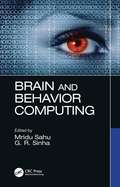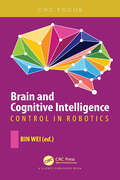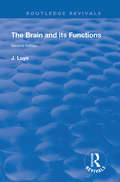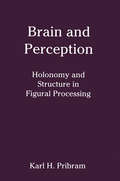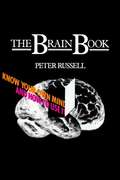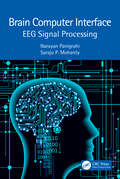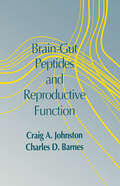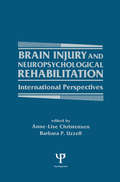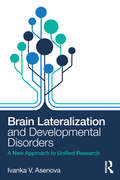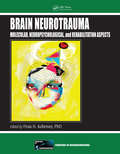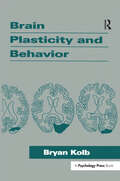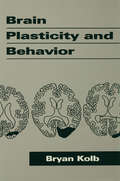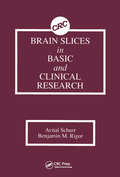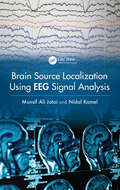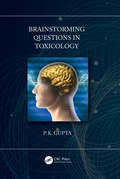- Table View
- List View
Brain and Behavior Computing
by Mridu Sahu G. R. SinhaBrain and Behavior Computing offers insights into the functions of the human brain. This book provides an emphasis on brain and behavior computing with different modalities available such as signal processing, image processing, data sciences, statistics further it includes fundamental, mathematical model, algorithms, case studies, and future research scopes. It further illustrates brain signal sources and how the brain signal can process, manipulate, and transform in different domains allowing researchers and professionals to extract information about the physiological condition of the brain. Emphasizes real challenges in brain signal processing for a variety of applications for analysis, classification, and clustering. Discusses data sciences and its applications in brain computing visualization. Covers all the most recent tools for analysing the brain and it’s working. Describes brain modeling and all possible machine learning methods and their uses. Augments the use of data mining and machine learning to brain computer interface (BCI) devices. Includes case studies and actual simulation examples. This book is aimed at researchers, professionals, and graduate students in image processing and computer vision, biomedical engineering, signal processing, and brain and behavior computing.
Brain and Cognitive Intelligence: Control in Robotics
by Bin WeiThe aim of the book is to introduce the state-of-the-art technologies in the field of brain and cognitive intelligence used in robotics control, particularly on studying how the brain learns and controls complex motor skills and how to replicate these in robots. This will be the first book that systematically and thoroughly deals with the above topics. Advances made in the past decades are described. Interesting topics such as human-robot interactions, neurorobotics, biomechanics in robotic control, robot vision, force control, and control and coordination of humanoid robots are covered.
Brain and Cognitive Intelligence: Control in Robotics
by Bin WeiThe aim of the book is to introduce the state-of-the-art technologies in the field of brain and cognitive intelligence used in robotics control, particularly on studying how the brain learns and controls complex motor skills and how to replicate these in robots. This will be the first book that systematically and thoroughly deals with the above topics. Advances made in the past decades are described. Interesting topics such as human-robot interactions, neurorobotics, biomechanics in robotic control, robot vision, force control, and control and coordination of humanoid robots are covered.
The Brain and its Functions (Routledge Revivals)
by J LuysFirst published in 1881. The present work, on the structure and functions of the brain, is an abstract of the author's persoal experience as regards this subject. It is divided into two distinct parts; the first, anatomical, serves as the foundation of the work. It is followed by a second, purely physiological, which is its complement and necessary sequence. It includes chapters on the optic thalamus, the corpus striatum, and the memory in exercise.
The Brain and its Functions (Routledge Revivals)
by J LuysFirst published in 1881. The present work, on the structure and functions of the brain, is an abstract of the author's persoal experience as regards this subject. It is divided into two distinct parts; the first, anatomical, serves as the foundation of the work. It is followed by a second, purely physiological, which is its complement and necessary sequence. It includes chapters on the optic thalamus, the corpus striatum, and the memory in exercise.
Brain and Perception: Holonomy and Structure in Figural Processing (Distinguished Lecture Series)
by Karl H. PribramPresented as a series of lectures, this important volume achieves four major goals: 1) It integrates the results of the author's research as applied to pattern perception -- reviewing current brain research and showing how several lines of inquiry have been converging to produce a paradigm shift in our understanding of the neural basis of figural perception. 2) It updates the holographic hypothesis of brain function in perception. 3) It emphasizes the fact that both distributed (holistic) and localized (structural) processes characterize brain function. 4) It portrays a neural systems analysis of brain organization in figural perception by computational models -- describing processing in terms of formalisms found useful in ordering data in 20th-century physical and engineering sciences. The lectures are divided into three parts: a Prolegomenon outlining a theoretical framework for the presentation; Part I dealing with the configural aspects of perception; and Part II presenting its cognitive aspects. The appendices were developed in a collaborative effort by the author, Kunio Yasue, and Mari Jibu (both of Notre Dame Seishin University of Okayama, Japan).
Brain and Perception: Holonomy and Structure in Figural Processing (Distinguished Lecture Series)
by Karl H. PribramPresented as a series of lectures, this important volume achieves four major goals: 1) It integrates the results of the author's research as applied to pattern perception -- reviewing current brain research and showing how several lines of inquiry have been converging to produce a paradigm shift in our understanding of the neural basis of figural perception. 2) It updates the holographic hypothesis of brain function in perception. 3) It emphasizes the fact that both distributed (holistic) and localized (structural) processes characterize brain function. 4) It portrays a neural systems analysis of brain organization in figural perception by computational models -- describing processing in terms of formalisms found useful in ordering data in 20th-century physical and engineering sciences. The lectures are divided into three parts: a Prolegomenon outlining a theoretical framework for the presentation; Part I dealing with the configural aspects of perception; and Part II presenting its cognitive aspects. The appendices were developed in a collaborative effort by the author, Kunio Yasue, and Mari Jibu (both of Notre Dame Seishin University of Okayama, Japan).
The Brain Book: Know Your Own Mind and How to Use it
by Peter RussellFirst published in 1980. Routledge is an imprint of Taylor & Francis, an informa company.
The Brain Book: Know Your Own Mind and How to Use it
by Peter RussellFirst published in 1980. Routledge is an imprint of Taylor & Francis, an informa company.
Brain Computer Interface: EEG Signal Processing
by Narayan Panigrahi Saraju P. MohantyBrain Computer Interface: EEG Signal Processing discusses electroencephalogram (EEG) signal processing using effective methodology and algorithms. This book provides a basic introduction to EEG and a classification of different components present in EEG. It also helps the reader to understand the scope of processing EEG signals and their associated applications. Further, it covers specific aspects such as epilepsy detection; exploitation of P300 for various applications; design of an EEG acquisition system; and detection of saccade, fix, and blink from EEG and EOG data. Key Features: Explains the basis of brain computer interface and how it can be established using different EEG signal characteristics Covers the detailed classification of different types of EEG signals with respect to their physical characteristics Explains detection and diagnosis of epileptic seizures from the EEG data of a subject Reviews the design and development of a low-cost and robust EEG acquisition system Provides mathematical analysis of EEGs, including MATLAB® codes for students to experiment with EEG data This book is aimed at graduate students and researchers in biomedical, electrical, electronics, communication engineering, healthcare, and cyber physical systems.
Brain Computer Interface: EEG Signal Processing
by Narayan Panigrahi Saraju P. MohantyBrain Computer Interface: EEG Signal Processing discusses electroencephalogram (EEG) signal processing using effective methodology and algorithms. This book provides a basic introduction to EEG and a classification of different components present in EEG. It also helps the reader to understand the scope of processing EEG signals and their associated applications. Further, it covers specific aspects such as epilepsy detection; exploitation of P300 for various applications; design of an EEG acquisition system; and detection of saccade, fix, and blink from EEG and EOG data. Key Features: Explains the basis of brain computer interface and how it can be established using different EEG signal characteristics Covers the detailed classification of different types of EEG signals with respect to their physical characteristics Explains detection and diagnosis of epileptic seizures from the EEG data of a subject Reviews the design and development of a low-cost and robust EEG acquisition system Provides mathematical analysis of EEGs, including MATLAB® codes for students to experiment with EEG data This book is aimed at graduate students and researchers in biomedical, electrical, electronics, communication engineering, healthcare, and cyber physical systems.
Brain-gut Peptides and Reproductive Function
by Charles D. Barnes Craig JohnstonThis book elucidates the role of brain-gut peptides in neuroendocrine regulation for understanding how these peptides interact with the reproductive neuroendocrine axis and for developing novel therapeutic agents for fertility or contraceptive therapies.
Brain-gut Peptides and Reproductive Function
by Charles D. Barnes Craig JohnstonThis book elucidates the role of brain-gut peptides in neuroendocrine regulation for understanding how these peptides interact with the reproductive neuroendocrine axis and for developing novel therapeutic agents for fertility or contraceptive therapies.
Brain Injury and Neuropsychological Rehabilitation: International Perspectives (Institute for Research in Behavioral Neuroscience Series)
by Anne-Lise Christensen Barbara P. UzzellMost individuals with brain damage experience a curtailment or loss of lifestyle without rehabilitation. Improved methods and appropriately timed medical interventions now make it possible for more individuals to survive brain insults and to be assisted by rehabilitation neuropsychologists in achieving renewed commitment to life. Damage to the brain -- the organ of human emotions and cognition -- reduces psychological functioning and realistic adaptation, and the patient and his/her family are often encapsulated in the time prior to injury. To regain part or most of the lifestyle lost, an honest, dedicated, and realistic approach is required. Neuropsychological rehabilitation can provide tools for this task, provided that the most comprehensive, elaborate and knowledge-based methods are integrated in the training, and provided that knowledge from many disciplines and from community environments and family is encompassed. In the present book knowledge representing the development of neuropsychological rehabilitation during the past five years is collected from a conference titled "Progress in Neuropsychological Rehabilitation." The chapters are written by professionals who were invited to share their experiences from different areas within the field because of their expertise with processes involved in neuropsychological rehabilitation. After a historical review, the chapters follow a visible sequence from biology to neuropsychology and neuropharmacology. Experts discuss the most advanced medical knowledge of the effect of injury on states of the organism. The second part of the book is dedicated to the outcome and the economics of rehabilitation as well as plans for the future. Finally, a panel discussion addresses the overall concept: Is rehabilitation worthwhile and ethical? The reactions -- influenced by the cross-cultural exchange of knowledge -- shed light on the essence and practice of today's neurorehabilitation.
Brain Injury and Neuropsychological Rehabilitation: International Perspectives (Institute for Research in Behavioral Neuroscience Series)
by Anne-Lise Christensen Barbara P. UzzellMost individuals with brain damage experience a curtailment or loss of lifestyle without rehabilitation. Improved methods and appropriately timed medical interventions now make it possible for more individuals to survive brain insults and to be assisted by rehabilitation neuropsychologists in achieving renewed commitment to life. Damage to the brain -- the organ of human emotions and cognition -- reduces psychological functioning and realistic adaptation, and the patient and his/her family are often encapsulated in the time prior to injury. To regain part or most of the lifestyle lost, an honest, dedicated, and realistic approach is required. Neuropsychological rehabilitation can provide tools for this task, provided that the most comprehensive, elaborate and knowledge-based methods are integrated in the training, and provided that knowledge from many disciplines and from community environments and family is encompassed. In the present book knowledge representing the development of neuropsychological rehabilitation during the past five years is collected from a conference titled "Progress in Neuropsychological Rehabilitation." The chapters are written by professionals who were invited to share their experiences from different areas within the field because of their expertise with processes involved in neuropsychological rehabilitation. After a historical review, the chapters follow a visible sequence from biology to neuropsychology and neuropharmacology. Experts discuss the most advanced medical knowledge of the effect of injury on states of the organism. The second part of the book is dedicated to the outcome and the economics of rehabilitation as well as plans for the future. Finally, a panel discussion addresses the overall concept: Is rehabilitation worthwhile and ethical? The reactions -- influenced by the cross-cultural exchange of knowledge -- shed light on the essence and practice of today's neurorehabilitation.
Brain Lateralization and Developmental Disorders: A New Approach to Unified Research
by Ivanka V. AsenovaBrain Lateralization and Developmental Disorders provides a comprehensive review of key findings and speculations from previous research on atypical cerebral lateralization in the most common neurodevelopmental disorders: stuttering, dyslexia, autism and intellectual disability. Emphasis is placed on recent studies, as well as descriptions of the author’s personal research which will provide a promising new direction for future research on these issues. In this text, Asenova presents four separate studies aiming to examine hemispheric asymmetries in neurodevelopmental disorders. These include the subtypes of developmental stuttering, the subtypes of developmental dyslexia, mild, non-syndromic intellectual disability with comorbid speech and language deficits and autism spectrum disorder with comorbid severe language impairment. The use of uniform research methods, including dichotic verbal perception tasks and lateral preference performance tests, has led to findings that suggest that this new approach could be a key factor in overcoming the ambiguity of findings from previous studies. By focusing on the discussion of key issues concerning the role of atypical laterality in the genesis of neurodevelopmental psychopathology in both past research and Asenova’s own studies, Brain Lateralization and Developmental Disorders is a valuable reading for students and researchers in neurodevelopmental psychopathology, as well as in developmental neuropsychology and developmental neuroscience.
Brain Lateralization and Developmental Disorders: A New Approach to Unified Research
by Ivanka V. AsenovaBrain Lateralization and Developmental Disorders provides a comprehensive review of key findings and speculations from previous research on atypical cerebral lateralization in the most common neurodevelopmental disorders: stuttering, dyslexia, autism and intellectual disability. Emphasis is placed on recent studies, as well as descriptions of the author’s personal research which will provide a promising new direction for future research on these issues. In this text, Asenova presents four separate studies aiming to examine hemispheric asymmetries in neurodevelopmental disorders. These include the subtypes of developmental stuttering, the subtypes of developmental dyslexia, mild, non-syndromic intellectual disability with comorbid speech and language deficits and autism spectrum disorder with comorbid severe language impairment. The use of uniform research methods, including dichotic verbal perception tasks and lateral preference performance tests, has led to findings that suggest that this new approach could be a key factor in overcoming the ambiguity of findings from previous studies. By focusing on the discussion of key issues concerning the role of atypical laterality in the genesis of neurodevelopmental psychopathology in both past research and Asenova’s own studies, Brain Lateralization and Developmental Disorders is a valuable reading for students and researchers in neurodevelopmental psychopathology, as well as in developmental neuropsychology and developmental neuroscience.
Brain Neurotrauma: Molecular, Neuropsychological, and Rehabilitation Aspects
by Firas H. KobeissyEvery year, an estimated 1.7 million Americans sustain brain injury. Long-term disabilities impact nearly half of moderate brain injury survivors and nearly 50,000 of these cases result in death. Brain Neurotrauma: Molecular, Neuropsychological, and Rehabilitation Aspects provides a comprehensive and up-to-date account on the latest developments in
Brain Plasticity and Behavior (Distinguished Lecture Series)
by Bryan KolbThere are few books devoted to the topic of brain plasticity and behavior. Most previous works that cover topics related to brain plasticity do not include extensive discussions of behavior. The first to try to address the relationship between recovery from brain damage and changes in the brain that might support the recovery, this volume includes studies of humans as well as laboratory species, particularly rats. The subject matter identifies a consistent correlation between specific changes in the brain and behavioral recovery, as well as various factors such as sex and experience that influence this correlation in consistent ways. Evolving from a series of lectures given as the McEachran Lectures at the University of Alberta, this volume originally began as a summary of the lectures, but has expanded to include more background literature, allowing the reader to see the author's biases, assumptions, and hunches in a broader perspective. In writing this volume, the author had two goals in mind: * to initiate senior undergraduates or graduate psychology, biology, neuroscience or other interested students to the issues and questions regarding the nature of brain plasticity, and * to provide a monograph in the form of an extended summary of the work the author and his colleagues have done on brain plasticity and recovery of function.
Brain Plasticity and Behavior (Distinguished Lecture Series)
by Bryan KolbThere are few books devoted to the topic of brain plasticity and behavior. Most previous works that cover topics related to brain plasticity do not include extensive discussions of behavior. The first to try to address the relationship between recovery from brain damage and changes in the brain that might support the recovery, this volume includes studies of humans as well as laboratory species, particularly rats. The subject matter identifies a consistent correlation between specific changes in the brain and behavioral recovery, as well as various factors such as sex and experience that influence this correlation in consistent ways. Evolving from a series of lectures given as the McEachran Lectures at the University of Alberta, this volume originally began as a summary of the lectures, but has expanded to include more background literature, allowing the reader to see the author's biases, assumptions, and hunches in a broader perspective. In writing this volume, the author had two goals in mind: * to initiate senior undergraduates or graduate psychology, biology, neuroscience or other interested students to the issues and questions regarding the nature of brain plasticity, and * to provide a monograph in the form of an extended summary of the work the author and his colleagues have done on brain plasticity and recovery of function.
Brain Slices in Basic and Clinical Research
by Avital Schurr Benjamin M. RigorBrain Slices in Basic and Clinical Research describes advancements in the field of brain function and dysfunction through use of central nervous system slice preparations. Topics are authored by leading scientists and include the following:Mechanisms of synaptic plasticity as the basis of memory processesChaos and synaptic variabilityBrain calcium currentsGlutamate receptorsPathophysiology of excitotoxinsCerebral hypoxia-ischemiaNeuronal injuryFree radicalsOptical methods of measuring brain metabolismVoltammetry in brain slicesCalcium imagingPatch-clamp recording and application of macromolecules through patch-clamp pipettes in brain slicesIntracellular double labeling of various neuronal populationsUse of brain slices in teaching neurophysiological methodsMost of the topics are published in book format for the first time, and some of the techniques are more fully detailed than in any other book.
Brain Slices in Basic and Clinical Research
by Avital Schurr Benjamin M. RigorBrain Slices in Basic and Clinical Research describes advancements in the field of brain function and dysfunction through use of central nervous system slice preparations. Topics are authored by leading scientists and include the following:Mechanisms of synaptic plasticity as the basis of memory processesChaos and synaptic variabilityBrain calcium currentsGlutamate receptorsPathophysiology of excitotoxinsCerebral hypoxia-ischemiaNeuronal injuryFree radicalsOptical methods of measuring brain metabolismVoltammetry in brain slicesCalcium imagingPatch-clamp recording and application of macromolecules through patch-clamp pipettes in brain slicesIntracellular double labeling of various neuronal populationsUse of brain slices in teaching neurophysiological methodsMost of the topics are published in book format for the first time, and some of the techniques are more fully detailed than in any other book.
Brain Source Localization Using EEG Signal Analysis
by Munsif Ali Jatoi Nidal KamelOf the research areas devoted to biomedical sciences, the study of the brain remains a field that continually attracts interest due to the vast range of people afflicted with debilitating brain disorders and those interested in ameliorating its effects. To discover the roots of maladies and grasp the dynamics of brain functions, researchers and practitioners often turn to a process known as brain source localization, which assists in determining the source of electromagnetic signals from the brain. Aiming to promote both treatments and understanding of brain ailments, ranging from epilepsy and depression to schizophrenia and Parkinson’s disease, the authors of this book provide a comprehensive account of current developments in the use of neuroimaging techniques for brain analysis. Their book addresses a wide array of topics, including EEG forward and inverse problems, the application of classical MNE, LORETA, Bayesian based MSP, and its modified version, M-MSP. Within the ten chapters that comprise this book, clinicians, researchers, and field experts concerned with the state of brain source localization will find a store of information that can assist them in the quest to enhance the quality of life for people living with brain disorders.
Brain Source Localization Using EEG Signal Analysis
by Munsif Ali Jatoi Nidal KamelOf the research areas devoted to biomedical sciences, the study of the brain remains a field that continually attracts interest due to the vast range of people afflicted with debilitating brain disorders and those interested in ameliorating its effects. To discover the roots of maladies and grasp the dynamics of brain functions, researchers and practitioners often turn to a process known as brain source localization, which assists in determining the source of electromagnetic signals from the brain. Aiming to promote both treatments and understanding of brain ailments, ranging from epilepsy and depression to schizophrenia and Parkinson’s disease, the authors of this book provide a comprehensive account of current developments in the use of neuroimaging techniques for brain analysis. Their book addresses a wide array of topics, including EEG forward and inverse problems, the application of classical MNE, LORETA, Bayesian based MSP, and its modified version, M-MSP. Within the ten chapters that comprise this book, clinicians, researchers, and field experts concerned with the state of brain source localization will find a store of information that can assist them in the quest to enhance the quality of life for people living with brain disorders.
Brainstorming Questions in Toxicology
by P. K. GuptaBrainstorming Questions in Toxicology is designed to serve as a comprehensive, quick reference supplement for various examinations that include sections on toxicology. It reflects the breadth and multidisciplinary nature of toxicology with an objective approach to the subject. With 3500 short questions and answers, multiple choice questions, true/false or correct/incorrect statements, fill in the blanks, and matching the statements, this book is a helpful tool for students, teachers and toxicologists preparing for licensure and certification exams. It is also a resource or refresher for toxicologists working in pharmacy, medical, clinical and forensic toxicology, veterinary, and other related fields such as environment and eco-toxicology. Key Features: Serves as a refresher for academicians and professionals in the field of toxicology Provides an essential guide for the student who needs a study aid for toxicology and the teacher of toxicology who needs inspiration when composing questions for their students Supplements in-house training courses in toxicology that exist in some pharmaceutical and chemical industries
